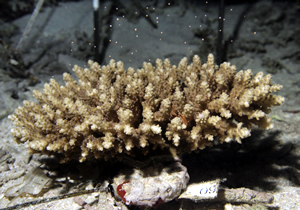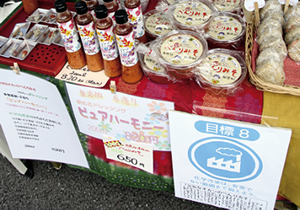Relay Column
Coral Reef Restoration Techniques through Seedling Production

Spawning of transplanted corals (Sekisei Lagoon, Okinawa)

Nineteen percent of the world's coral reefs have already been degraded. Another 60% or more currently face serious threats.*1 Due to various disturbances such as coral bleaching and the outbreak of starfish, the degradation of many of these coral reefs has already exceeded nature's regenerative capacity. Coral reef restoration is therefore a crucial.*2
The conventional technique for coral restoration, however, lacked genetic diversity. In addition, its approach of transplanting fragments of existing coral communities damaged the donor corals. We, IDEA consultants, Inc. therefore developed an alternative series of coral reef restoration techniques. Ceramic coral-settling devices (50 mm Ø X 30 mm h) are installed on the sea floor during spawning time, and coral larvae are settled, nursed, and then transplanted as seedlings. This series of techniques requires no special facility, and by allowing for the easy transplantation of coral, enables the production of large amounts of biologically diverse seedlings at a low cost. The Ministry of the Environment's coral reef restoration project for the Iriomote-Ishigaki National Park, Okinawa Prefecture, has confirmed the successful spawning of transplanted corals for the fifth consecutive year (see photo). We congratulate this significant achievement in coral reef restoration, and strongly hope for the contribution of our technique to coral reef restoration around the world.
More Information:
*1 ICRI (2013) A Continuing Call to Action.
*2 Rinkevich B (2005) Conservation of coral reefs through active restoration measures: Recent approaches and last decade progress, Environ. Sci. Technol., 39:4333-43452.
Evoking a Sense of Ownership Regarding Biodiversity

Booths at TOWARDS COP12, Osaka

We, the Japan Civil Network for the United Nations Decade on Biodiversity, are deeply concerned about the poor recognition of biodiversity and its endangerment among Japanese people. In March 2014, we conducted the "Survey on Awareness of Biodiversity" with 30,000 respondents. While 62% responded that "risks in society will increase," only 16.2% indicated a perceived risk over biodiversity loss. While biodiversity ranked 12th of 16 perceived risk factors, issues closely related to biodiversity such as climate change (2nd) and radioactive contamination (5th) were perceived as high risks. These results may be due to a lack of recognition of the term, "biodiversity".
To alter this situation, we held an event to stimulate interest in the Conference of the Parties (COP12) of the Convention on Biological Diversity. We invited various people including organic farmers and crafters to exhibit booths and asked them to discuss how their work falls under an Aichi Biodiversity Target. The respective Target icon at each booth immediately boosted exhibitors' sense of ownership on the topic. As each of us depends on biodiversity, ownership of the topic is vital in conservation and sustainable biodiversity use. We will continue our effort for the successful achievement of the Aichi Biodiversity Targets.



